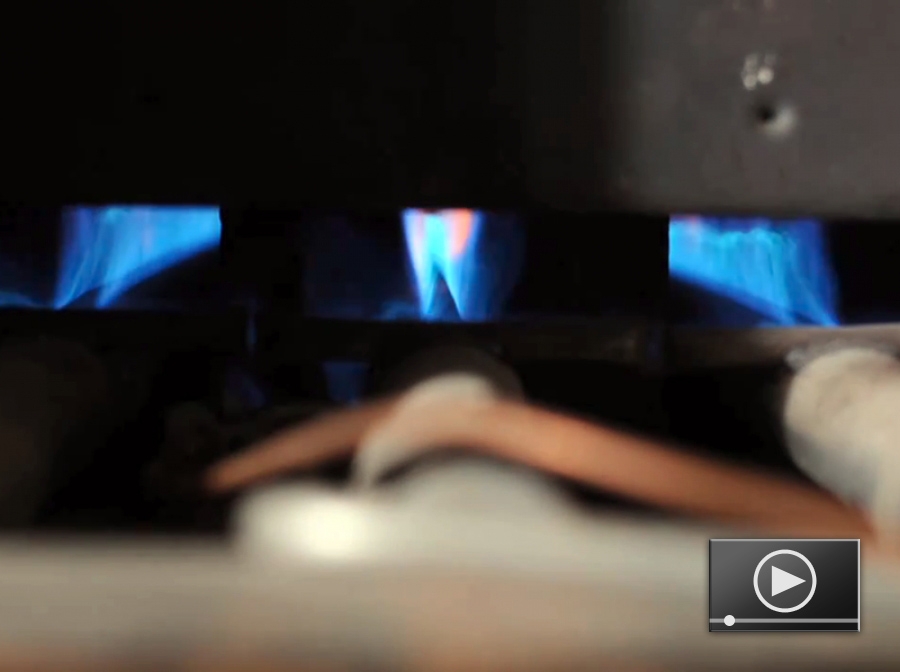How to Maintain a Furnace
Video
The old saying, ďAn ounce of prevention is worth a pound of cureĒ couldnít be truer when it comes to your furnace. Whether you have an oil, gas, or electric furnace, itís important for your health, safety, and even your home budget, to perform regular checks and maintenance. Join our host, Jeff Wilson, for a review of some simple tips and tricks to keep your furnace operating safely at its highest efficiency.

There are many types of furnaces, but the one thing they all have in common is that they burn something to heat the air that warms your home. (An electric furnace uses electricity to heat a metallic heating element.) An important fact about a furnace that burns a fuel, like gas or oil, is that the combustion gases must be properly exhausted. The fuel gas is burnt in a chamber in the furnace and the combustion by-products, including carbon monoxide, are drawn into a flue to be exhausted to the outside.
Without entering the house, you can make sure those gases are exhausted by means of a visual inspection of the flue for holes or corrosion. If you find sections that are corroded, those should be replaced. If you find small holes or areas where the flue piping has come apart, use foil tape or sealant made especially for flues to make the repairs.
This is also a good time to change the batteries in, or install, carbon monoxide detectors. Carbon monoxide is one of the most dangerous flue gases. Itís odorless and colorless and very harmful. If your home has a gas furnace, itís a good idea to install a carbon monoxide detector and alarm in the places where your family sleeps. It is also a good idea to install one near the furnace. Check your local building codes to see whether your home is required to have a carbon monoxide detector. Your homeownerís or renterís insurance may also offer a discount if you install and maintain one.
Types of Furnace Filters
The most common maintenance to perform on your furnace is changing the furnace filter. Typically located where the return air duct connects to the furnace, the filter removes dirt, dust, and allergens from the air and keeps the fresh, warm air clean as it flows into your home. Your local hardware or home improvement store offers several options for replacement furnace filters.
- Fiberglass Filter: This is the most inexpensive option, is disposable, usually will last about 30 days, and offers a minimum level of particle filtration.
- Pleated Filter: One of the most common styles, this is designed to filter varying levels of particles, contaminants, and allergens; is disposable; and will last up to 90 days. [Pleated filters are often rated on the Minimum Efficiency Reporting Value (MERV) scale from 1 (least efficient) to 16 (most efficient), with a higher number filtering out more types and smaller particles.]
- Electrostatic Filter: Washable and reusable, this creates a static charge to remove particles. It should be washed or cleaned about every 90 days, is highly efficient when maintained properly, and is the greenest option in that less waste is contributed to a landfill.
How to Change a Furnace Filter
Regardless of what type of filter you use, changing the furnace filter is done in much the same way. First, turn off the furnace completely at the electrical disconnect switch located next to the furnace. If the furnace does not have a disconnect switch, shut off the furnace breaker at the electric panel. Some furnace models have an exposed blower motor with which you could actually come in contact. You do not want this to start up while youíre working in the furnace.
Once the furnace is off, find and open the access panel to your filter. Some furnaces have a separate access panel for the filter, while others just have a slot into which the filter slides. The filter is typically located on the side where the return air, the cool air from the house, comes into the furnace.
The existing filter should slide out pretty easily. When installing the new filter, itís important to pay attention to the arrows on the filter. The arrows will tell you which direction the air should flow and should be pointing toward the furnace and away from the ducts. Once you have determined the orientation of the filter, it should slide into the slot from which the old one was removed.
Once youíve installed the new filter, you should vacuum and clean out any excess dirt and grime inside the furnace ducts. Itís also a good time of year to clean out any dirt and debris from the floor vents in your house. After youíve completed any necessary cleanup, shut the access panel and turn the furnace on.
Thatís about it for the routine maintenance. For combustion-type furnaces, itís smart to have a professional out every few years to check the combustion with a combustion analyzer and adjust your furnace to make sure it is burning at its highest efficiency.


